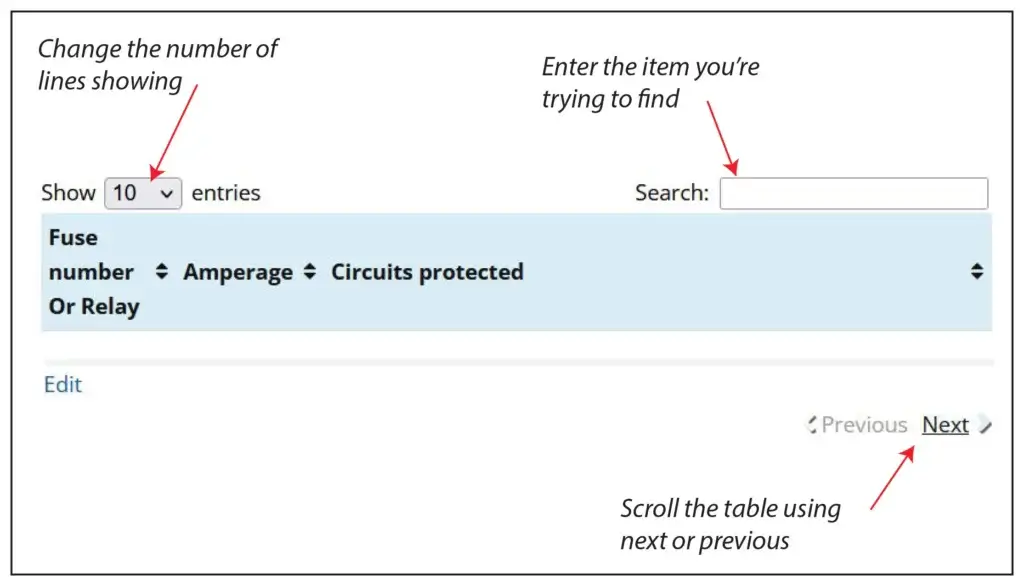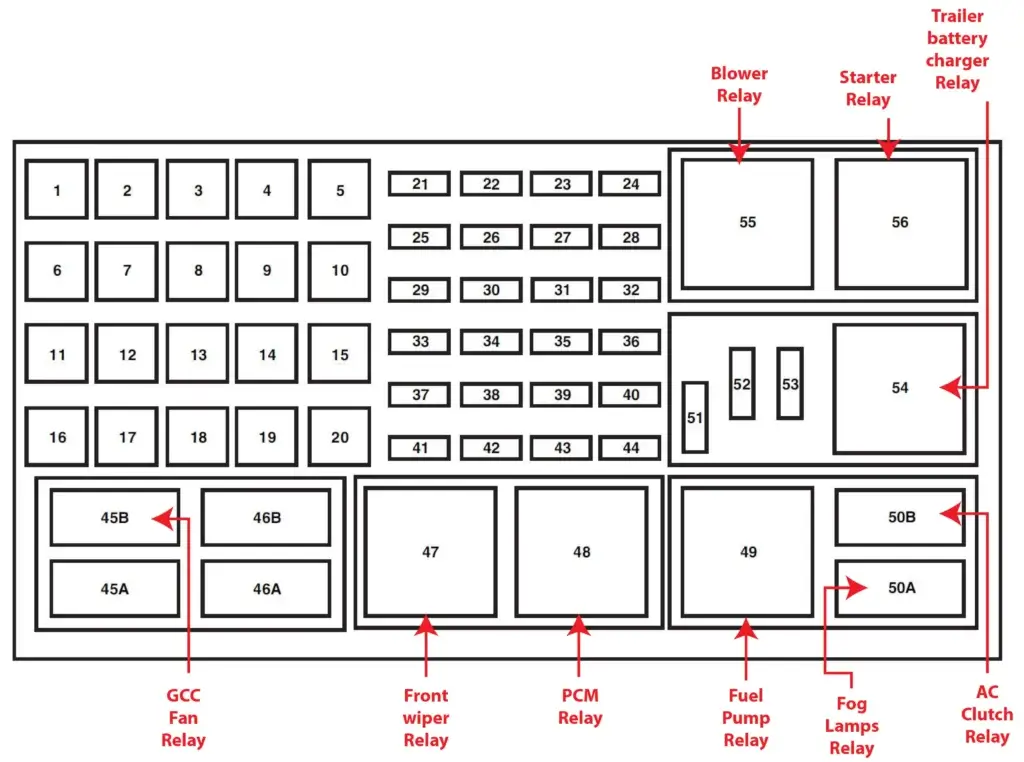2006 Explorer Fuse Box Diagram: Exploring the Fuse Boxes
2006 Explorer Fuse Box Diagram: Find the correct fuse for the circuit
This 2006 Explorer Fuse Box Diagram article shows two fuse boxes. The power distribution box is also called the battery junction box and is located under the hood on the driver’s side near the firewall. It’s a rectangular box next to the brake master cylinder. The fuse and relays for the higher-powered devices are located in that fuse box.
The Power distribution box is a new design for the 2006 model year. The fuse and relay layout is completely different from previous years.
The Passenger Compartment Fuse Box, also called the Smarty Junction box, is located under the dash on the driver’s side.
To learn more about automotive fuses, see this article
To learn how to check a fuse visually or without removing it, see this article
Find the most commonly replaced fuses here
The fuse box diagram and table below show all 62 fuses and all the relays. But most DIYers are looking for fuses and relays for the lights, power ports, and the blower motor. I’ve listed the most commonly checked/replaced fuses here to save time. I’ve also listed the most commonly replaced bulbs. A blown fuse or bulb are the two most common reasons for lighting issues.
SJB= Smart Junction Box/Passenger Compartment Fuse Box. PDB=Power Distribution Box
• Backup Light: Fuse #15 10A SJB
• Blower Motor: Fuse #16 40A PDB, Auxiliary Blower Motor Fuse #18 30A PDB
• Headlight Low and High Beam Passenger Side: Fuse #29 10A PDB
• Headlight Low and High Beam Driver’s Side: Fuse #34 10A PDB
• Horn: Fuse #14 20A PCFB
• Power Ports: Rear Power Point Fuse #21 20A PDB, Front Power Point/Cigar Lighter Fuse #25 20A PDB,
• Stop/Turn/Brake: Fuses #7 15A, SJB
• Parking lamps: Fuse #26 15A SJB
A note about fuses, battery power and keep alive memory
If you disconnect the battery or remove the PCM fuses from the fuse box, the PCM will lose its adaptive memory and baseline throttle body position. You can avoid this by providing backup power using a jumper pack and an inexpensive OBDII cable. See this article for more information on providing backup power to prevent the loss of adaptive memory. Or, you can perform a throttle body relearn procedure and then drive the vehicle so it can relearn the new adaptive memory settings. See this article for instructions on how to perform a 2006 Explorer throttle body relearn procedure.
2006 Explorer Fuse Box Diagram for Battery Junction Box/Power Distribution Box
The power distribution box is located in the engine compartment on the driver’s side. Find it near the firewall next to the master cylinder and wiper motor. The power distribution box contains high-current fuses that protect your vehicle’s main electrical systems from overloads.
How to find your fuse and the devices served by that fuse
There are 60 fuse/relay slots in the Battery Junction Box. The chart shows only 10 to speed up load time. Here’s how to find the fuse and circuit you want.
1) Change the number of entries showing (in the Show Entries Box) to 100 and scroll the list.
2) Enter the name of the component you’re searching for in the Search box.
3) Use the Next/Previous buttons at the bottom of the table

PJB= Passenger Junction Box
HEGO = Heated Exhaust Gas Oxygen Sensor
VMV= Vapor Mangement Valve
PTEC= Powertrain Electronic Control Module (PCM)
CMS= Central Security Module
BSM= Body Security Module
CHMSL= Center High Mounted Stop Light
| Fuse number | Amperage | Circuits protected |
|---|---|---|
| F1 | 50 | BATT 2 (Smart Junction Box |
| F2 | 50 | BATT 3 (Smart Junction Box |
| F3 | 50 | BATT 1 (Smart Junction Box |
| F4 | 30 | Fuel pump, Injectors |
| F5 | 30 | Third row seat (left) |
| F6 | 40 | IVD module |
| F7 | 40 | Powertrain Control Module (PCM) |
| F8 | — | Not used |
| F9 | — | Not used |
| F10 | 30 | Power seat (right) |
| F11 | 30 | Starter |
| F12 | 30 | Third row seat (right) |
| F13 | 30 | Trailer tow battery charger |
| F14 | 30/40 | Memory seats (DSM)/Non-memory seats |
| F15 | 40 | Rear defrost, Heated mirrors |
| F16 | 40 | Blower motor |
| F17 | 30 | Trailer electronic brakes |
| F18 | 30 | Auxiliary blower motor |
| F19 | — | Not used |
| F20 | — | Not used |
| F21 | 20 | Rear power point |
| F22 | 20 | Subwoofer |
| F23 | 20 | 4x4 |
| F24 | 10 | Powertrain Control Module (PCM) KAP, CAN vent |
| F25 | 20 | Front power point/Cigar lighter |
| F26 | 20 | 4x4 module |
| F27 | 20 | 6R Transmission module |
| F28 | 20 | Heated seats |
| F29 | 20 | Headlamps (right) |
| F30 | 25 | Rear wiper |
| F31 | 15 | Fog lamps |
| F32 | — | Not used |
| F33 | 30 | IVD module |
| F34 | 20 | Headlamps (left) |
| F35 | 10 | AC clutch |
| F36 | — | Not used |
| F37 | 30 | Front wiper |
| F38 | 15 | 5R Transmission |
| F39 | 15 | PCM power |
| F40 | 15 | Fan clutch, PCV valve, AC clutch relay, GCC fan |
| F41 | 15 | SDARS/DVD |
| F42 | 15 | Redundant brake switch, EVMV, MAFS, HEGO, EVR, VCT1, VCT2, CMCV, CMS |
| F43 | 15 | Coil on plug (4.6L engine only), Coil tower (4.0L engine only) |
| F44 | 15 | Injectors |
| F45A | — | Not used |
| F45B | Relay | GCC fan relay |
| F46A | — | Not used |
| F46B | — | Not used |
| F47 | Relay | Front wiper relay |
| F48 | Relay | PCM relay |
| F49 | Relay | Fuel pump relay |
| F50A | Relay | Fog lamps relay |
| F50B | — | AC clutch relay |
| F51 | — | Not used |
| F52 | — | A/C clutch (diode) |
| F53 | — | Not used |
| F54 | Relay | Trailer battery charger relay |
| F55 | Relay | Starter relay |
| F56 | Relay | Blower relay |
Explorer Fuse Box Diagram for Cabin/Passenger Compartment Fuse Panel
The cabin fuse panel is on the instrument panel’s far left side. Ford refers to this as the passenger compartment fuse box or the smart junction box (SJB).
| Fuse number | Amperage | Circuits protected |
|---|---|---|
| F1 | 20 | Moonroof, Adjustable pedals, DSM, Memory lumbar motor |
| F2 | 5 | Microcontroller power (SJB) |
| F3 | 20 | Radio |
| F4 | 20 | OBD II connector |
| F5 | 5 | Moonroof |
| F6 | 20 | Liftglass release motor, Door unlock/lock |
| F7 | 15 | Trailer stop/turn |
| F8 | 15 | Ignition switch power, PATS |
| F9 | 2 | 6R TCM/PCM (Ignition RUN/START), Fuel pump relay |
| F10 | 5 | Front wiper RUN/ACC relay in PDB |
| F11 | 5 | Radio start |
| F12 | 5 | Rear wiper motor RUN/ACC, Trailer battery charge relay in PDB, Radio |
| F13 | 15 | Heated mirror, Rear defrost indicator |
| F14 | 20 | Horn |
| F15 | 10 | Reverse lamps |
| F16 | 10 | Trailer reverse lamps |
| F17 | 10 | RCM, PAD lamp, OCS module |
| F18 | 10 | Reverse park aid, IVD switch, IVD, 4x4 module, 4x4 switch, Heated seat switches, Compass, Electrochromatic mirror, AUX climate control |
| F19 | — | Not used |
| F20 | 10 | Manual climate, DEATC, Brake shift |
| F21 | — | Not used |
| F22 | 15 | Brake switch, Bi-color stop lamps, CHMSL all turn |
| F23 | 15 | Power mirrors, Interior lamps, Puddle lamps, Battery saver, Instrument illumination, Homelink |
| F24 | 10 | Cluster, Theft LED |
| F25 | 15 | Trailer park, Trailer electronic brake module |
| F26 | 15 | License plate/rear park lamp, Front park lamps, Manual climate |
| F27 | 15 | Tri-color stop lamps |
| F28 | 10 | Manual/DEATC |
| Circuit Breaker 1 | 25A | Windows |
Auxiliary Relay Panel
Locate the Auxiliary Relay Panel in the cabin on either side of the Cabin Fuse Panel
Relay 1 Delayed ACC
Relay 2 Rear defrost
Relay 3 Park lamps
Relay 4 RUN/START
Tips to diagnose electrical issues on your 2006 Explorer
Headlight operation
Unlike in older models, the multifunction headlight switch does not switch power to the headlights. It is simply a request for headlights. The multifunction switch has a series of resistors that drop voltage as you turn the stalk. The smart junction box determines whether you’re requesting parking lights, headlights, or high-beam lights based on the voltage drop. The actual power switching of power from the headlight fuse to the headlights is done inside the smart junction box.
If your headlights aren’t working and the headlight fuses are good, the easiest way to diagnose the problem is to use a bidirectional scan too to view live data from the smart junction box. You will see that on the scan tool if it’s receiving the headlights ON request. However, if you’ve turned the stalk to headlights and the smart junction box isn’t seeing the request, then the problem is in the multifunction switch or the wiring from the MF switch to the SHB
If your power windows don’t work
• Power to the windows is provided on Fuse #1 in the PDB. It then flows to the Accessory Delay Relay in the Smart Junction Box. From there, power flows to a 25A circuit breaker for the power windows.
If your blower motor doesn’t work
The blower motor gets its power from the blower motor relay #55 in the battery junction/power distribution box.
If the circuit you’re working on contains a relay
• A simple way to test a relay is to swap in a similarly shaped relay and see if the component works.
• If that doesn’t work, remove the relay and test for power to the relay control coil and contacts using a multimeter. For more information on relay testing, see this article.
©, 2018 Rick Muscoplat


